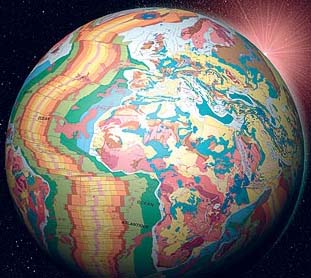Complex life existed on Earth more than 400 mln yrs earlier than believed
 Sydney, April 22 : In an analysis of fossil deposits in central India, an international team of geologists has found that complex life, in the form of multicellular organisms, existed on earth more than 400 million years earlier than previously thought.
Sydney, April 22 : In an analysis of fossil deposits in central India, an international team of geologists has found that complex life, in the form of multicellular organisms, existed on earth more than 400 million years earlier than previously thought.
According to a report by ABC News, the finding comes out of research aimed at ending controversy over the age of the Vindhyan basin in central India.
The controversy concerns two fossil discoveries in 1998, which gave conflicting views over when the Vindhyan sedimentary basins, which spread over more than 100,000 square kilometers of central India, were formed.
At the time, Indian geologist Dr Rafat Azmi reported finding small, shell-like fossils, which were typical of those that date to the Cambrian era about 500 to 600 million years ago.
However, German researcher, Dr Adolf Seilacher, discovered a network of mini-tunnels that he claimed were the trace fossils of complex, worm-like organisms estimated to be about 1.2 billion years old.
In the new research, Australian researcher Professor Birger Rasmussen says that the discrepancy in the two reports had “profound implications” for geological dating and needed to be resolved.
They say that errors, which were later discovered in Azmi’s reports, “were taken to suggest they were fundamentally flawed and that the skeletal fossils did not exist”.
However, in the new report, the authors say Azmi’s fossils are real, and are more than a billion years older than he claimed.
The discovery is important as it gives new insight into the earth''s biosphere in the Palaeoprotorezoic era, 1.6 billion years ago.
According to Rasmussen, of Curtin University in Perth, the size of the fossil tubes is consistent with them being the traces of multicellular eukaryotic algae.
“Previously accepted multicellular eukaryotes were only known from the late Mesoproterozoic or early Neoproterozoic (some 400 to 600 million years later),” according to the team.
“Put simply, it shows there were more complex organisms around earlier than we thought,” Rasmussen said.
For the study, members of the team travelled with Azmi to collect specimens, which were then analysed in Sweden and Australia.
In Australia, Rasmussen dated the fossils by analysing the decay of uranium inside zircon crystals, while in Sweden they used electron radiation x-ray tomographic microscopy to date the microfossils.
Rasmussen said that both methods found the “likely age of the Lower Vindhyan is from the end of the Palaeoproterozoic about 1700 and 1600 million years ago”. (ANI)